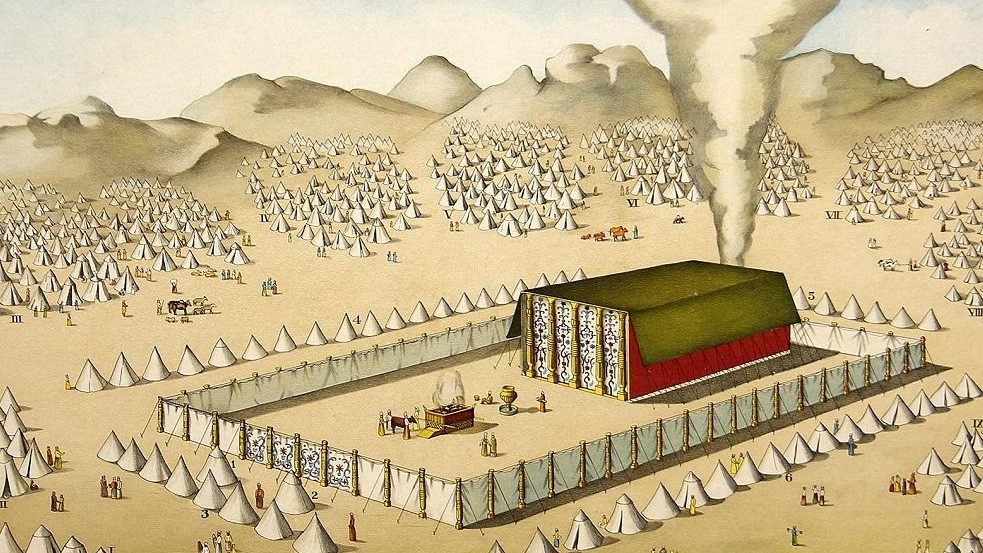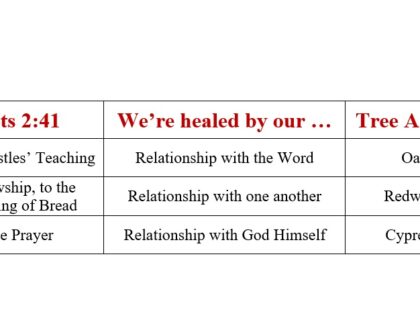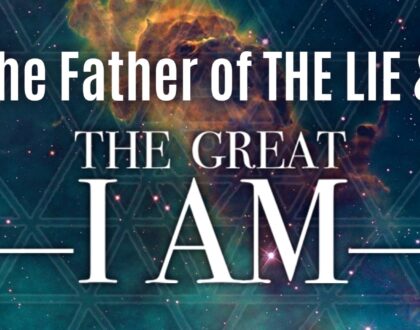The Word Became Flesh and ‘Tabernacled’ Among Us

by Pastor Gene
John likes symbolism, as even a surface reading of the Book of the Revelation of Jesus Christ will readily show. But John’s Gospel has its allusions and symbols too.
One of these we find in the jaw-dropping declaration of John 1:14: “And the Word became flesh and dwelt among us, and we have seen his glory, glory as of the only Son from the Father, full of grace and truth.” The word “dwelt” in this verse (Greek, σκηνόω) wants to pull us back to the Old Testament wilderness wanderings of Israel where the glory of God dwelt among the people in a movable tent called the Tabernacle.
Similar to the way “God’s presence was in the Tabernacle (Exodus 40:34), so Jesus dwelt among people” (Blum, John, in The Bible Knowledge Commentary: An Exposition of the Scriptures, Vol. 2, p. 273).
This passage is literally telling us that Jesus – the very glory of God – “tabernacled” among us. Much has been written about the significance of this, and rightly so! But no one to my mind has laid it out more succinctly than Arthur W. Pink in his wonderful commentary on John’s Gospel (Exposition of the Gospel of John, Swengel, PA: Bible Truth Depot, 1923).
The similarities between the Old Testament Tabernacle and the “tabernacling” of Jesus among men listed below summarize Dr. Pink’s fine work. Wherever you find lines in quotations, they’re direct quotes from him; the brackets are mine.
God Pitched His Tent
In Jesus, God pitched His tent among us for thirty-three years. The Tabernacle that God instructed Moses to erect for Him in the wilderness foreshadowed the coming Christ in many ways. In fact, virtually every thing about the Tabernacle pointed to the coming of Jesus Christ! Notice a few of these:
- The “Tabernacle” was a temporary dwelling place for the glory of God. In this it differed from the temple of Solomon, which was to be a permanent The Tabernacle was merely a tent … something that was suited to be moved about from place to place during the journeyings of the children of Israel. So it was when our blessed Lord Tabernacled here among men. His stay was but a brief one—less than forty years … and … He abode not long in any one place, but was constantly on the move … A careful study of the chronology of the Pentateuch seems to indicate that Israel used the Tabernacle in the wilderness less than thirty-five years!”
- The Tabernacle was designed for use in the “wilderness” – a picture of Jesus coming to this world of sin in His first advent. The more permanent Temple, however, pictures Christ’s second coming and the establishment of His Millennial reign.
- Outwardly the “Tabernacle was humble and unattractive in appearance. Altogether unlike the costly and magnificent temple of Solomon, there was nothing in the externals of the Tabernacle to please the carnal eye. Nothing but plain boards and skins. So it was at the Incarnation. The Divine majesty of our Lord was hidden beneath a veil of flesh … To the unbelieving gaze of Israel, He had no form nor comeliness; and when they beheld Him, their unanointed eyes saw in Him no beauty that they should desire Him.”
- The Tabernacle was “the place where God met with men.” It was called the “tent of meeting.” If an Israelite desired to draw near to YHWH, He had to come to the door of the Tabernacle. When giving instructions to Moses concerning the making of the Tabernacle and its furniture, God said, “You shall put the mercy seat on the top of the ark, and in the ark you shall put the testimony that I shall give you. There I will meet with you …” (Exodus 25:21-22a). “How perfect is this lovely type! Christ is the meeting place between God and men. No man cometh unto the Father but by Him (John 14:16). There is but one Mediator between God and men—the Man Christ Jesus (1 Timothy 2:5). He is the One who spans the gulf between deity and humanity, because He is Himself both God and Man.
- The “Tabernacle” was the place where the Law was preserved. The first set of the Ten Commandments were broken (Exodus 32:19), but the “second set were deposited in the ark in the Tabernacle for safe keeping (Deuteronomy 10:2-5). It was only there, within the Holy of Holies, the tablets of the Law were preserved intact. How this, again, speaks to us of Christ! He it was that said, “Then I said, “Behold, I have come; in the scroll of the book it is written of me: I delight to do your will, O my God” (Psalm 40:7-8). Throughout His perfect life He preserved in thought, word and deed, the Divine Decalogue, honoring and magnifying God’s Law.”
- The Tabernacle “was the place where sacrifice was made. In its outer court stood the brazen altar, to which the animals were brought, and on which they were slain. There it was that blood was shed and atonement was made for sin. So it was with the Lord Jesus. He fulfilled in His own Person the typical significance of the brazen altar, as of every piece of the Tabernacle furniture. The body in which He tabernacled on earth was nailed to the cruel Tree. The Cross was the altar upon which God’s Lamb was slain, where His precious blood was shed, and where complete atonement was made for sin.”
- The Tabernacle “was the place of worship. To it the pious Israelite brought his offerings. To it he turned when he desired to worship [YHWH]. From its door the Voice of the Lord was heard …” In a similar way, it is only by Jesus that “we are to offer unto God a sacrifice of praise (Hebrews 13:15). It is in Him, and by Him, alone, that we can worship the Father. It is through Him we have access to the throne of grace.”
The Wilderness Tabernacle & Solomon’s Temple
Pink goes on to describe “a series of striking contrasts between the wilderness Tabernacle and Solomon’s Temple” in the way that each of these foreshadow the coming of Christ. Here are some of them:
- “The Tabernacle foreshadowed Christ in His first advent; the Temple looks forward to Christ at His second advent.”
- “The Tabernacle was first, historically; the Temple was not built until long afterwards.”
- “The Tabernacle was but a temporary erection; the Temple was a permanent structure.”
- “The Tabernacle was erected by Moses the prophet (which was the office Christ filled during His first advent); the Temple was built by Solomon the king (which is the office Christ will fill at His second advent).”
- “The Tabernacle was used in the wilderness—speaking of Christ’s humiliation; the Temple was built in Jerusalem, the “city of the great King” (Matthew 5:35)—speaking of Christ’s future glorification.”
No Mere Book!
Now, these wonderful foreshadowings remind us of the supernatural divine inspiration of the Bible. It is no mere book! In an article about the unity of the Bible (Unity of the Bible: Seven Compelling Evidences, July 27, 2014), Tim Chaffery writes:
“Among all the books ever written, the Bible is absolutely unique. Actually, it is not just a book—it’s 66 books. And one of its most remarkable qualities is the complete unity of the overall message despite having so many different authors writing over many centuries on hundreds of controversial subjects. Natural explanations fail to account for the supernatural character and origin of Scripture.
The Bible was written over a period of roughly 2,000 years by 40 different authors from three continents, who wrote in three different languages …
Shepherds, kings, scholars, fishermen, prophets, a military general, a cupbearer, and a priest all penned portions of Scripture. They had different immediate purposes for writing, whether recording history, giving spiritual and moral instruction, or pronouncing judgment. They composed their works from palaces, prisons, the wilderness, and places of exile while writing history, laws, poetry, prophecy, and proverbs. In the process they laid bare their personal emotions, expressing anger, frustration, joy, and love.
Yet, despite this marvelous array of topics and goals, the Bible displays a flawless internal consistency. It never contradicts itself or its common theme.
From Genesis to Revelation, we see man’s repeated rebellion against his holy Creator. God made a perfect world, but mankind has continually rejected His authority and sought to decide truth for himself. Nevertheless, God promised to extend His love, grace, and mercy to unworthy people who deserved to be cast into the lake of fire for all eternity.
Early in Genesis after Adam and Eve sinned, God made known His plan of redemption, which He repeatedly promised and expanded upon throughout the Old Testament. The promises were fulfilled in a surprising, but predicted way: by the Savior’s sacrificial death and subsequent resurrection, as recorded in the New Testament. The Bible then announced the future culmination of the Savior’s redemptive work in [the Book of] Revelation.”
Amen and Amen!
God has fulfilled the promises He made in His Word by sending His Son Jesus into the World! “The Word became flesh and tabernacle among us, and we have seen his glory, glory as of the only Son from the Father, full of grace and truth!”
To Consider
- Can you think of other Old Testament symbols that foreshadowed Jesus? (How about Passover? The animal sacrifices, etc.?)
- How do these speak to the truthfulness of God’s Word?
- How does discovering the faithfulness of God in the way He has already fulfilled so many of His promises give you confidence in promises that are yet future?
What are some of the promises that God has made to you?
Do you believe He will fulfill every one?
- As a believer, does the Bible have the place of prominence it deserves in your life?
Think About Peter’s response in John 6 after many of Jesus’ disciples had left Him. “Jesus said therefore to the twelve, “You do not want to go away also, do you?” Simon Peter answered Him, “Lord, to whom shall we go? You have words of eternal life” (John 6:67-68).
How would you characterize the words of God found in the Bible?
Are they the very “words of eternal life” to you as they were to Peter?
Is reading them a part of your daily routine?
If not, why not? What does this tell you about where you are spiritually? What might you do to change this?
Recommended Posts
Comments
Comments are closed.




GOD HAS BEEN GOOD TO ME HE BLESSED ME WITH THE CHURCH AN DMY CAT HE SAVE ME IN1980 WHEN I GOT HIT BY ACAR AND WHENI GOT HIT HERE IN WOONSOCKE T IN 2007 HE IS IS AGOOD GOD I AM THANKFULL THA T IGOT HIM IN MY LIFE.